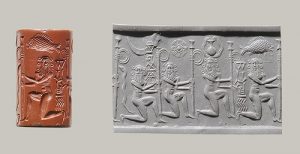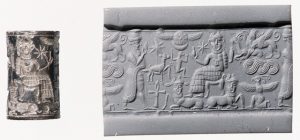Handprints and Writing
Lecture Summary
In this week’s lecture focused on 35,000 BCE-0 CE, we discussed the developments communication in writing. What intrigued me the most was how the complexities of communication had all started with the idea of cave paintings. This drove me to wonder how else mankind of this era were able to communicate, other than through this form of art. It was the illustrations of animals/environments on cave walls, which then lead to the evolution of understanding the land and people around them.
After this Paleolithic period, we discussed a lot of how the idea of language, storytelling and handwriting had been evolved all around the globe. From the Sumerian people’s Cuneiform, to ancient Egypts hieroglyphics, all the way to Ancient Greek’s Literature, all these forms of writing are tied together by the idea of visual communication; also stemming from the basis of the early communication systems, pictographs, ideographs and phonographs.

Bimbetka Cave Art
Cylinder seals are small stone objects created as a form of identification in the daily life of Mesopotamia. These small stones, made of semi-precious stone (agate, chalcedony, lapis lazuli, steatite, limestone, marble, quartz, serpentine, hematite and jasper) have intricate designs to symbolize the distinctiveness of its owner. It was used by all classes, from kings, merchants and as well as slaves. It was rolled along documents on wet clay like an impression stamp, serving as a personal signature for businesses. 
Cylinder Seal with Kneeling Nude Heroes, c. 2220-2159 B.C.E.
The designs of these cylinders clearly demonstrates the artistic styles of this era, as well as the daily life and motifs of this time period. It includes details of agricultural activities, music, dance, travelling and themes of Heroic actions, mythic endeavours, Gods and daily life. These designs were well thought out to describe and reflect its owner. Cylinder seals were also worn as protective amulets, serving to protect them from evil. They were worn as necklaces, bracelets, or pinned to their garments.
Cylinder Seal, c. 1820-1730 B.C.E.
Sources:
Text:
https://www.khanacademy.org/humanities/ancient-art-civilizations/ancient-near-east1/sumerian/a/cylinder-seals
https://www.ancient.eu/article/846/cylinder-seals-in-ancient-mesopotamia—their-hist/
Photographs:
https://www.ancient.eu/uploads/images/3536.jpg?v=1485681234
https://www.khanacademy.org/humanities/ancient-art-civilizations/ancient-near-east1/sumerian/a/cylinder-seals